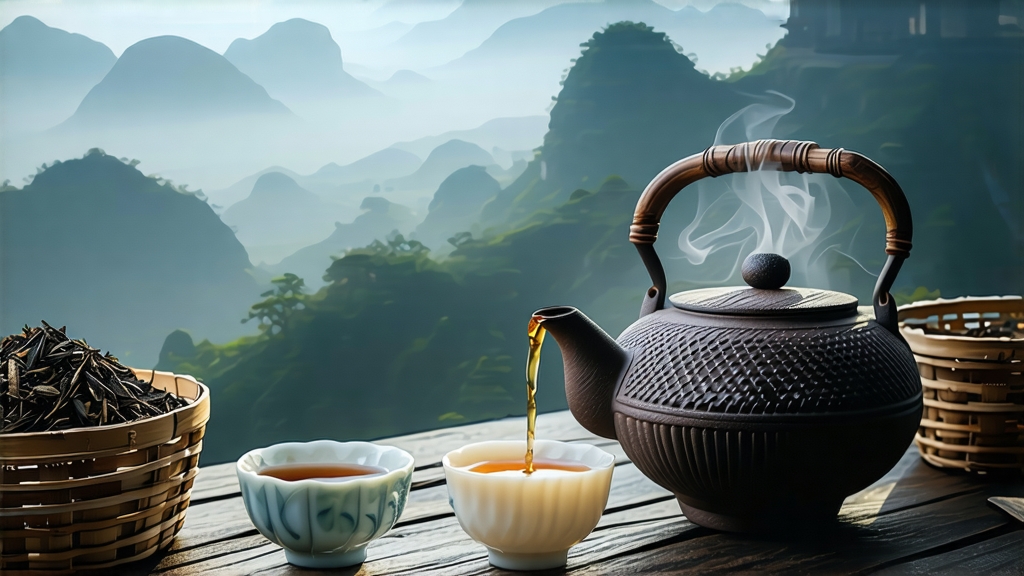
Tucked away in the southern folds of China’s Guangxi Zhuang Autonomous Region, Liu Bao tea has spent four centuries quietly perfecting the art of fermentation while remaining almost unknown outside Chinese-speaking circles. To the global tea family it is a “dark tea” (hei cha), the same technological category that shelters better-known Pu-erh, yet Liu Bao possesses a personality entirely its own: a silky, woody liquor that carries the scent of damp camphor forest, a sweet finish reminiscent of longan fruit, and a remarkable ability to improve for decades when stored with care. This article invites the international reader to discover Liu Bao’s history, sub-styles, craftsmanship, brewing rituals, and tasting vocabulary, so that the next time you search for a new dark tea adventure, Guangxi’s best-kept secret will be on your map.
-
Historical footprints from military tea to maritime currency
Liu Bao takes its name from the old Liu Bao market town in Wuzhou prefecture, the historic trading hub where leaf grown in the adjacent Da Wu and Liu Bao mountains was collected, packaged, and sent down the Xun River to the Pearl River delta. The earliest written record appears in the 1669 edition of the Wuzhou Gazetteer, noting that “the Liu Bao variety is pressed into large baskets and shipped to Guangzhou, where foreigners pay silver for it.” Those foreigners were primarily merchants from British, Dutch, and Portuguese trading houses who valued the tea for its resistance to mold on long sea voyages. During the Qing dynasty the tea became part of the “military tea” (bian cha) system: compressed bricks and baskets traveled on mule caravans to the northern frontiers, where lacto-fermentation softened the rough leaf and provided nutrients for soldiers weary of millet and mutton. In the early 20th century Liu Bao again changed roles, becoming a form of hard currency among overseas Chinese communities in Singapore and Kuala Lumpur; vintage 1958 and 1973 baskets still surface at Malaysian estate sales, their paper tickets intact, fetching prices higher than single-malt whisky. -
Terroir: limestone peaks and subtropical humidity
The core micro-region lies between 23° and 24° north latitude, where granite and limestone peaks rise 800–1,200 m above sea level. Day-night temperature swings of 10 °C slow the growth of the indigenous large-leaf cultivar (Camellia sinensis var. assamica cv. Guangxi Daye), concentrating polyphenols and caffeine. Frequent mist blocks intense UV, encouraging the production of sweet amino acids, while the karst bedrock filters groundwater into soft, mineral-rich irrigation. These geographic signatures survive the fermentation process and reappear in the cup as a cooling menthol note and a stony minerality that Chinese tasters liken to “the breath of a limestone cave after rain.” -
From fresh leaf to aged treasure: the six acts of Liu Bao craft
a) Plucking: only the standard “three leaves and a bud” shoot is picked during the 12-day window between Qingming and Guyu, when the leaf’s catechin-to-theaflavin ratio is optimal for subsequent microbial fermentation.
b) Solar withering: trays are set on bamboo racks for 3–4 hours under 70 % shade cloth; the goal is 65 % moisture loss, judged by the classic “pinch test” where a leaf cracks but does not snap.
c) Indoor piling: the Guangxi innovation. Partially dried leaf is piled 70 cm deep in pine-lined rooms maintained at 28 °C and 85 % RH. Thermophilic bacteria (Bacillus subtilis, B. licheniformis) dominate the first 48 h, raising the pile core to 55 °C and initiating the Maillard reactions that generate Liu Bao’s signature “betel-nut” aroma. Every 12 h the pile is turned by barefoot workers who rely on sole sensitivity to detect hot spots.
d) Loose-leaf re-drying: after 10–15 days the pile is spread thin and dried with low-temperature (60 °C) charcoal fires, arresting bacterial activity while preserving fungal spores (Aspergillus niger, Eurotium cristatum) that will drive slow aging.
e) Steaming and basket pressing: the leaf is steamed for 90 seconds